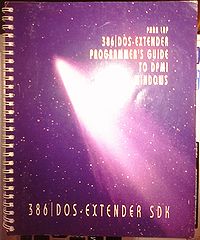Difference between revisions of "386 DOS-Extender"
From Computer History Wiki
(add in some links for 4.1) |
m (Re-classify) |
||
| (One intermediate revision by one other user not shown) | |||
| Line 4: | Line 4: | ||
By using special [[compiler]]s [[Watcom C]] 386, and HighC 386 you could create a 32-bit [[program]] that would run on an unmodified [[MS-DOS]] system equipped with a [[Intel 80386|386]] [[CPU]]. It was significantly easier to deploy 386 extended [[application]]s, however it did carry a significant price tag, compared to deploying [[OS/2 2.0]], although it was much more simpler. | By using special [[compiler]]s [[Watcom C]] 386, and HighC 386 you could create a 32-bit [[program]] that would run on an unmodified [[MS-DOS]] system equipped with a [[Intel 80386|386]] [[CPU]]. It was significantly easier to deploy 386 extended [[application]]s, however it did carry a significant price tag, compared to deploying [[OS/2 2.0]], although it was much more simpler. | ||
| − | |||
= Versions = | = Versions = | ||
| Line 11: | Line 10: | ||
Documents include: | Documents include: | ||
| − | * [https://archive.org/details/386- | + | * [https://archive.org/details/386-dosx-installation-instructions 386|DOS-Extender Installation Instructions] |
| − | * [https://archive.org/details/386- | + | * [https://archive.org/details/386-vmm-installation-instructions 386|VMM Installation Instructions] |
| − | * [https://archive.org/details/386-asm | + | |
| − | * [https://archive.org/details/386-debug 386 | + | * [https://archive.org/details/386-asm 386|ASM Reference Manual] |
| − | * [https://archive.org/details/386- | + | * [https://archive.org/details/386-debug 386|DEBUG Reference Manual] |
| − | * [https://archive.org/details/386- | + | * [https://archive.org/details/386-dosx 386|DOS Extender Reference Manual] |
| − | * [https://archive.org/details/386- | + | * [https://archive.org/details/386-link 386|LINK Reference Manual] |
| − | * [https://archive.org/details/386- | + | * [https://archive.org/details/386-vmm 386|VMM Reference Manual] |
| − | * [https://archive.org/details/386- | + | |
| − | * [https://archive.org/details/386- | + | * [https://archive.org/details/386-lib 386|LIB Utility Guide] |
| − | * [https://archive.org/details/386- | + | |
| − | * [https://archive.org/details/386-link 386 | + | * [https://archive.org/details/386-asm-reference-card 386|ASM Reference Card] |
| − | * [https://archive.org/details/386- | + | * [https://archive.org/details/386-debug-reference-card 386|DEBUG Reference Card] |
| − | * [https://archive.org/details/386- | + | * [https://archive.org/details/386-dosx-reference-card 386|DOS-Extender Reference Card] |
| − | * [https://archive.org/details/386- | + | * [https://archive.org/details/386-link-reference-card 386|LINK Reference Card] |
| − | * [https://archive.org/details/cfig-386 | + | |
| + | * [https://archive.org/details/386-asm-release-notes-41 386|ASM Release Notes 4.1] | ||
| + | * [https://archive.org/details/386-debug-release-notes-41 386|DEBUG Release Notes 4.1] | ||
| + | * [https://archive.org/details/386-dosx-release-notes-41 386|DOS-Extender Release Notes 4.1] | ||
| + | |||
| + | * [https://archive.org/details/cfig-386 CFIG386 Utility Guide] | ||
== 5.x == | == 5.x == | ||
== 6.x == | == 6.x == | ||
| − | {{stub}} | + | {{semi-stub}} |
[[Category: DOS Enhancements]] | [[Category: DOS Enhancements]] | ||
Latest revision as of 23:19, 12 October 2024
The 386|Dos-Extender was the first real MS-DOS extender created by Phar Lap.
By using special compilers Watcom C 386, and HighC 386 you could create a 32-bit program that would run on an unmodified MS-DOS system equipped with a 386 CPU. It was significantly easier to deploy 386 extended applications, however it did carry a significant price tag, compared to deploying OS/2 2.0, although it was much more simpler.
Contents
Versions
4.1
A copy of the 4.1 SDK as been scanned and placed on archive.org! You can find it here.
Documents include:
- 386|ASM Reference Manual
- 386|DEBUG Reference Manual
- 386|DOS Extender Reference Manual
- 386|LINK Reference Manual
- 386|VMM Reference Manual
- 386|ASM Reference Card
- 386|DEBUG Reference Card
- 386|DOS-Extender Reference Card
- 386|LINK Reference Card
